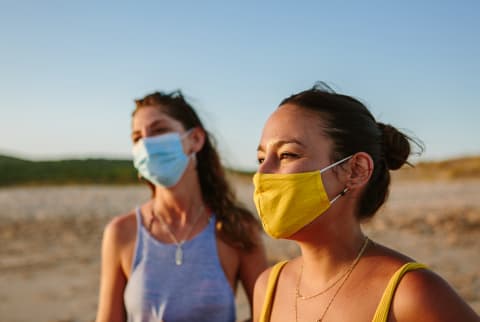Which Mask Material Is Best For Your Skin? A Dermatologist Explains


Maskne. Need we say more? While wearing masks is absolutely necessary (wear them, please!), we can't ignore how those cloth coverings can wreak havoc on the skin, especially as the summer heat remains in full force. To get a handle on your mask-induced breakouts, you might apply a soothing moisturizer as a pre-protective measure and avoid comedogenic products under the mask area. But did you know you can actually choose a mask material to suit your skin type?
Neither did we. That is, until we tapped board-certified dermatologist Elizabeth Mullans, M.D., to break down which fabric is best for skin. Her answer, below.
Which mask material is best for your skin type?
According to Mullans, 100% cotton is the way to go. Whether you have dry, sensitive, oily, or acne-prone skin, cotton is key for a couple of reasons. First up: "Cotton absorbs the sweat, saliva, and oils better than other materials," she explains. So for those oily and acne-prone individuals (whose maskne may stem from trapped oils, sweat, and bacteria), cotton is able to wick away the moisture, so all that humidity won't hover above your skin for some time (a gross visual, but it's true).
Second, cotton is also a softer material, Mullans says, which means it's less likely to irritate the skin from friction. As we know, maskne is much more than a cluster of clogged pores. Rather, there are two types of maskne that can occur when wearing face masks: both breakouts and contact friction. Cotton is able to manage both skin care gripes in one fell swoop. That's what makes 100% cotton the go-to for dry and sensitive skin as well—if your skin resembles steel wool after donning the cloth covering, you might want to consider making a material switch.
Of course, because cotton absorbs so well, you need to wash it after each use. Otherwise all that oil and sweat it was wicking away will go right back into your pores. This, of course, is true for any reusable mask. Essentially: Washing the mask is a vital part of keeping acne at bay.
Cotton may be the best DIY protective material, too.
Cotton doesn't only win on the skin care front. In fact, recent research has found that tightly woven cotton (as well as chiffon) could be most effective for filtering out droplet particles. Again, cotton has the ability to absorb excess sweat and oils from the skin; it makes sense the material would be able to filter respiratory droplets from the outside in as well. Of course, that doesn't mean health care workers should swap out their N95 medical masks in favor of cotton counterparts—but if you are tasked with crafting homemade protective gear, cotton might be the best fabric to snag.
Just check your labels to make sure your fabric is, in fact, 100% cotton. Synthetic materials can cause irritation when those harsh fabrics rub on the skin, so take a moment to peek at the ingredients—the material's main ingredient might be cotton, but there could be some synthetic outliers thrown into the mix. Types of cotton might matter, too: Because cloth face masks should be made with at least two layers of fabric, you might consider a tightly woven cotton (high-quality quilting cotton, perhaps) for the outside, with a softer, jersey-knit layer for the underbelly that's touching your skin.
The takeaway.
Let's face it: Masks aren't going anywhere anytime soon. So why not choose a covering that suits your skin? Sure, you might be drawn to patterns or colors that let your personality shine through (since, you know, we can't exactly send a friendly smile to strangers on the street) or a favorite brand converting their deadstock fabrics into protective gear, but with skin care front of mind, perhaps regard the type of material as the highest priority. You might still face some discomfort in the summer heat (there's not much we can do about that, unfortunately), but your skin may be notably less irritated.

Jamie Schneider is the Beauty Editor at mindbodygreen. She has a B.A. in Organizational Studies and English from the University of Michigan, and her work has appeared in Coveteur, The Chill Times, and more. In her role at mbg, she reports on everything from the top beauty industry trends, to the gut-skin connection and the microbiome, to the latest expert makeup hacks. She currently lives in Brooklyn, New York.